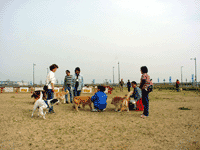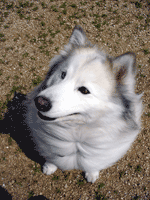|
|
| EVENT
NAME |
Port
Island 'Daiohanabatake'
Dog Run 21: The First Run in Kobe
|
| PURPOSE |
Under
the words 'Hanaminato Kobe', meaning 'a town symbolized by flowers, nature
and people living in harmony', we have enjoyed an opportunity to consider
the subject of people coexisting with their dogs, perhaps nature's closest
companion to humankind. At the same time we were able to consider how
to create more attractive towns in which people and animals can live together. |
| AIMS |
The aim
of the Dog Run was to create a multiple exchange opportunity between people
and dogs, people and people, and dogs and dogs. It was also about raising
awareness for animal protection and about treating our pets more correctly.
We also wanted to help people relearn their sense of wonder for the greatness
of nature, flowers and animals that surrounds us. |
| DATES
& TIMES |
March
24 (Sat) - May 6 (Sun) 200l 44 days
Time 10:30 -16:00 (cancelled if raining)
Dates closed due
to rain were: 6 days
(3/25, 3/29, 4/12, 4/21, 4/25, 5/2)
Partially closed: 4 days
(3/28 12:00 - 16:00, 4/3 12:00 -16:00
4/24 10:30 - 14:00, 4/29 13:30 -16:00)
|
| VENUE: |
Port
Island 'Daiohanabatake' Dog Run 21 Area |
| ORGANIZER: |
Dog Run
21 Executive Committee |
| SUPPORTED
BY: |
Friskie
K.K |
| MANAGEMENT: |
NPO Knots |
| |
| Final
Report
 We
were very fortunate in having so many fine and glorious days. This helped
attract a lot of visitors. Everybody who came, regardless of whether
they came with their pets or not, were clearly having a good time and
stayed for long hours. We can confidently report that we concluded the
event successfully and without any negative incident. We believe this
can be attributed in great part to the help of the trainers who controlled
the site while judging the master / dog relationships (evaluated by
recall-tests), and the dog / dog relationships (by affinity tests). We
were very fortunate in having so many fine and glorious days. This helped
attract a lot of visitors. Everybody who came, regardless of whether
they came with their pets or not, were clearly having a good time and
stayed for long hours. We can confidently report that we concluded the
event successfully and without any negative incident. We believe this
can be attributed in great part to the help of the trainers who controlled
the site while judging the master / dog relationships (evaluated by
recall-tests), and the dog / dog relationships (by affinity tests). I think that all who came to the facility were pleased to find professional
trainers present. This meant everybody could relax which undoubtedly
contributed to ensuring a good end-result. The number of 'repeaters'
gradually increased. Each Master learned how to lead their dogs, when
socializing with other dogs, through affinity tests. Some of them commented
that they no longer had any problems when taking their dog for a walk
or that their dogs had changed. Others wanted to know where they could
go for guidance after the final Dog Run day. Everyone was sad when the
Dog Run came to an end. There were many visitors who came along without
dogs. Among them were a 3-month-old baby as well as people with special
needs, both physical and mental, and some people with senile dementia.
Such visitors were able to gain positive stimulation from the event.
It was obvious that the Dog Run can be an enjoyable leisure time meeting
point for all generations of people and dogs, and equally open to people
who do not keep dogs of their own.
I think that all who came to the facility were pleased to find professional
trainers present. This meant everybody could relax which undoubtedly
contributed to ensuring a good end-result. The number of 'repeaters'
gradually increased. Each Master learned how to lead their dogs, when
socializing with other dogs, through affinity tests. Some of them commented
that they no longer had any problems when taking their dog for a walk
or that their dogs had changed. Others wanted to know where they could
go for guidance after the final Dog Run day. Everyone was sad when the
Dog Run came to an end. There were many visitors who came along without
dogs. Among them were a 3-month-old baby as well as people with special
needs, both physical and mental, and some people with senile dementia.
Such visitors were able to gain positive stimulation from the event.
It was obvious that the Dog Run can be an enjoyable leisure time meeting
point for all generations of people and dogs, and equally open to people
who do not keep dogs of their own.
|
|
 One
entry requirement we specified was that people must attach both a license
and rabies vaccination tag on their dogs. We found that many people
usually do not bother to attach these tags. (Fortunately, those who
we could not allow inside came back the next time with the appropriate
tags attached). Some people registered again in order to enter the Dog
Run. In fact, as approximately half the visitors would not have been
able to enter under the rule, we did admit those who could provide evidence
of the registration tag numbers. Even then about one-third of visitors
were not allowed in each day. One
entry requirement we specified was that people must attach both a license
and rabies vaccination tag on their dogs. We found that many people
usually do not bother to attach these tags. (Fortunately, those who
we could not allow inside came back the next time with the appropriate
tags attached). Some people registered again in order to enter the Dog
Run. In fact, as approximately half the visitors would not have been
able to enter under the rule, we did admit those who could provide evidence
of the registration tag numbers. Even then about one-third of visitors
were not allowed in each day. But while this rule remains a legal requirement, it should be strictly
enforced. It is a very effective weapon in the campaign to prevent the
spreading of rabies. In 1999, Hyogo Prefecture received 3,997 strays.
While 415 of these dogs were returned to their masters, 3,582 could
not be returned. Basically there are only three days of stay time after
they have been brought in. If those dogs had been fitted with license
(name) and rabies vaccination tags, they could have all been returned
to their owners. This reminds us that the tags are not only important
for rabies prevention but also for ensuring lost dogs are returned to
their masters.
But while this rule remains a legal requirement, it should be strictly
enforced. It is a very effective weapon in the campaign to prevent the
spreading of rabies. In 1999, Hyogo Prefecture received 3,997 strays.
While 415 of these dogs were returned to their masters, 3,582 could
not be returned. Basically there are only three days of stay time after
they have been brought in. If those dogs had been fitted with license
(name) and rabies vaccination tags, they could have all been returned
to their owners. This reminds us that the tags are not only important
for rabies prevention but also for ensuring lost dogs are returned to
their masters.
(So
one message we have for all our supporters is, if you want to fully
protect your much-loved family member, make sure you always put the
right tags on your dog.)
|
| |
|
Treatment and Sterilization (for feces and urine):
| Mokusu
liquid spraying: |
Two
sprayings during the period |
| Tools
(only) Sterilization: |
Pakoma,
in diluted solution. |
| Urine
treatment: |
Owners
used a watering can to pour diluted EM solution over the urination
point. This is very effective for eliminating the smell of urine. |
| Feces
treatment: |
 Collect
and compost. We asked many people to cooperate in composting feces
waste. Treating with diluted EM solution, straw and rice bran was
used. Collect
and compost. We asked many people to cooperate in composting feces
waste. Treating with diluted EM solution, straw and rice bran was
used.
Waste that was buried immediately decomposed completely and changed
the quality of soil. (We thank everybody for their cooperation).
Composting was successful and the waste returned to the soil very
effectively.
|
| |
|
|
Participation
Response
 As
more visitors turned out than were expected our staff responded by bringing
in their dogs for the weekend dates to teach people about petting etc.
This initiative proved very popular. Many people came to understand the
therapeutic value of animals. To see or be near happy dogs in itself was
judged to be of great benefit. For those families who cannot keep dogs
due to their housing circumstances, the opportunity to touch animals was
clearly a very precious experience, especially for the young children.
They were also less nervous than you might expect due to the presence
of dog-handling specialists. As
more visitors turned out than were expected our staff responded by bringing
in their dogs for the weekend dates to teach people about petting etc.
This initiative proved very popular. Many people came to understand the
therapeutic value of animals. To see or be near happy dogs in itself was
judged to be of great benefit. For those families who cannot keep dogs
due to their housing circumstances, the opportunity to touch animals was
clearly a very precious experience, especially for the young children.
They were also less nervous than you might expect due to the presence
of dog-handling specialists.
|
Towards the Future
 After
44 event days, we came to see that a Dog Run is an event style that
can fully achieve its goals. Held under a system that utilizes the expertise
of specialists it is useful for not only those who have their own dog,
but also for those without a dog. The event was an excellent platform
to facilitate exchanges between people and people, people and dogs,
and dogs and dogs. To see the people going home at the end with such
happy expressions was far more than we ever expected. There were many
repeaters, too. After
44 event days, we came to see that a Dog Run is an event style that
can fully achieve its goals. Held under a system that utilizes the expertise
of specialists it is useful for not only those who have their own dog,
but also for those without a dog. The event was an excellent platform
to facilitate exchanges between people and people, people and dogs,
and dogs and dogs. To see the people going home at the end with such
happy expressions was far more than we ever expected. There were many
repeaters, too.
30% of all households
in Japan now keep some kind of pet so, especially in the Kansai region
where a greater volume of urbanization has been going forward, a Dog
Run is a fixture that should be actively encouraged as a form of social
mission. The expression on the faces of visitors (whether they were
owners or not) and dogs as they left the venue demonstrated this need
eloquently. Now that the coexistence of people and animals has been
receiving attention and an emphasis within youth education and aged
welfare, we shall try to search for better management methods that involve
the cooperation of relevant groups, to serve as a basis for the coexistence
of people and animals. If a Dog Run can be established as a permanent
fixture we believe there are a number of possibilities.
|
|
|
| |
|
|
|